Visiting Elephant Hills in Khao Sok National Park was one of the most beautiful and enriching experiences of my life. If you are planning to visit this article contains a range of tips to help your trip go smoothly.Although December to March is the best time to visit this area of Thailand from a weather perspective, Elephant Hills is open all year round – the elephants still need sanctuary and food, rainforest life still goes on, rainy season or not. We visited over New Year, so during the dry season.
Location: Khao Sok National Park, Cheow Lan Lake, Ratchaprapa Dam, Surat Thani Province, Thailand.
Although we found some guidance on the Elephant Hills official website, and I gleaned a bit from an odd blog post here and there, I couldn’t find a single source that addressed all my questions. I hope from our experience to be able to give you that now. I was also worried about food, as my daughter has a pretty severe peanut allergy and I wasn’t sure how well the camps could cater for her needs.
What to pack?
During our Elephant Hills experience, we took part in feeding elephants, river canoeing, lake canoeing, lake swimming, longtail boat rides, rainforest trekking and caving. Be aware there are two camps, one each for the rainforest and lake locations. We stayed one night in a tent in the rainforest camp, and a second on a floating tent on Cheow Lan Lake. Although you will have all your luggage with you at the rainforest camp, you need to be prepared to pack a smaller travel bag with only the essentials for your time at the lake camp.
One of the challenges we faced was trying to keep the extra items we would only need for the rainforest to a minimum in order not to exceed our overall luggage weight allowance for our flights. Read on to see what we decided on and what recommendations I have for you based on our experience. If you just want to view our packing list, skip to the end, however reading on might help to understand a bit about what to expect as you may decide on a different packing strategy.
Shoes for the hike
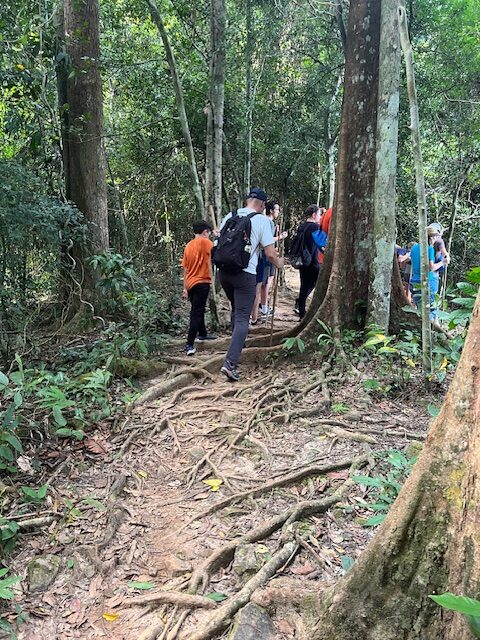
Possibly the bulkiest and heaviest additional item to pack, we debated long and hard on what shoes to take with us from the UK. I saw recommendations for everything from walking boots to wet shoes. We packed wet shoes as we already knew they would be handy for other parts of our holiday. Some of us had walking trainers which we took, and the rest of us took old trainers.
Old trainers for the hike during dry season are absolutely fine. Walking boots in my view would have been overkill, even if there was a shower or two. The hike is about 2.5 hours long, and consists of fairly steep trails, sometimes with grab ropes, following terrain that is a mix of dusty soil, soft red clay, sharp rocks and twisted roots.
I do not think wet shoes would be a good idea for the trek, despite some blogs saying they would be fine – the sharp rocks and the sheer duration of the hike would leave you with sore feet; likewise sandals or open toed shoes would not be suitable. In rainy season, I would recommend a waterproof trainer or walking boot, as two hours with wet feet wouldn’t be much fun. For the record, we did this hike with an 11, 14 and 16 year old, none of them particularly keen walkers, but they had no problem and enjoyed it.
Clothes for the hike
Lightweight, long sleeve tops and trousers were recommended for the hike. The challenge for us was although my husband and I had lightweight utility trousers suitable for hiking, the boys and my daughter did not, and I didn’t want to buy new ones solely for one tropical hike that they probably would never use again.

So our compromise for the boys was to take their quick-dry Nike joggers, which although of a thick-ish fabric did work quite well – the boys didn’t overheat, their legs were protected, and it didn’t matter if they got dirty. My daughter on the other hand didn’t have any suitable trousers, so opted for the longest shorts we could find, and slathered exposed skin with insect repellent, which we reapplied every half hour or so. She did not get bitten, but her experience of the cave (where there were lots of jumping insects at ankle level in the dark), was different to those of us with trousers on!
We all wore short sleeved T-shirts (and slathered insect repellent all over our arms) and were absolutely fine. We packed but did not need our raincoats – definitely overkill in dry season, when even if it does rain heavily it is shortlived and more refreshing than anything. In rainy season, it might be a good idea to take raincoats though, as 2.5 hours of wet walking may not be much fun.
From a hat perspective, for the hike, we took hats but didn’t actually need them. The sun barely made it through the canopy, and the longtail boat we took to get to the trail had a large canopied area so no-one sat in full sun.
Clothes for elephant feeding and rainforest canoeing
For us, normal clothes were absolutely fine to wear here – shorts, T-shirts, suncream obviously, plus insect repellent. We didn’t get dirty feeding the elephants, and shorts/T-shirts were comfortable for canoeing. Swimming costumes are not needed as there is no swimming during these activities.
Shoes for elephant feeding and rainforest canoeing
These two activities usually happen on the same afternoon. For us it was on our first afternoon after arriving at the rainforest camp during the morning. On a side note, the transfers operated by Elephant Hills from our hotel to the camp, and then onwards to our next point of travel (for us, Phuket Marina for a boat transfer) were efficient, seamless and professional. We had time to settle into our tent, enjoy the swimming pool (which we didn’t even know existed!) and get ready for the afternoons activities. As we knew we were canoeing after visiting the elephants, we decided we’d wear our wet shoes for the whole afternoon, rather than taking them to change into. This was absolutely fine; there was not much walking, so feet didn’t get too sore. Our feet didn’t get wet during the canoeing, so you could risk it and wear trainers for the whole thing, but just think there is a risk of you getting wet and then the worry about drying trainers for the next activity.
Clothes and shoes for lake canoeing

This is an easy one to answer – the best outfit is your swimming costume and bare feet. Everyone has to wear a lifejacket when on the water in the National Park – otherwise you can be fined by the authorities – and this is regardless of if you are on a longtail boat or canoe. So by default you will be wearing this extra layer. You will get your feet, legs and arms wet whilst canoeing. You are not going to get out of your canoe to walk on shore, and the bottom of the lake is at least 20m deep (so no need for wet shoes). Most of us just lathered up with high factor suncream and went for it in our swimmers. It’s definitely a good idea to wear a baseball hat for this activity. I took a beach straw hat, which was a pain as you spend a lot of time looking up into trees looking at monkeys and birds. I wish I had had a straightforward cap, to give a bit of shade to your head and face.
What else to expect?
From a food perspective, you do not have to worry about going hungry. Mealtimes were regular and prompt, and the food available was varied and delicious. We loved the gong indicating meal times – how simple yet effective. Water is freely available at all mealtimes (announced with a gong!), and tea, coffee and juice in the mornings. For those travelling with children with limited taste for Thai food, there were western options at a buffet food station for younger guests (eg pizza, mini burgers) which also had the advantage of opening earlier than the regular buffet to satisfy hungry kids.
Allergies and dietary requirements
If you are travelling with anyone with dietary requirements, the Elephant Hills team are very professional and experienced in catering for them. My daughter has a peanut allergy, and although we had our pre-prepared ‘what can I eat that does not contain peanuts or any peanut-derived ingredient etc’ cards in Thai, they provided us with an extra card for the duration of our trip. She then showed this card to a member of waiting staff before each meal and they would point out what dishes she could not have.
The team are capable of dealing with all kinds of dietary requirements; there were vegan dishes on offer, and those with more broad intolerances and allergies had their own plates of food prepared for them which were laid out in a specific area near the buffet. I saw GF and dairy-free platters made up for guests, as an example.
For any drinks other than water, and for snacks outside of mealtimes, each camp has a well stocked bar with snacks including nuts and Pringles. The bars are cash only – you can add the cost to your room, but the bill needs to be settled in cash when you check out. Prices were quite reasonable.
During your visit to the elephant sanctuary, you will be able to visit their cafe which serves ice creams, cold drinks, tea and coffee. You can charge these to your room, so no need to take cash. The tents are provisioned with plentiful bottled water, and there’s a cold drinking water dispenser in the main restaurant to fill your travel water bottles.
Water safety
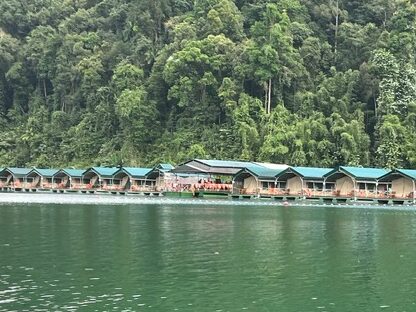
When travelling by boat, kayak or even swimming on Cheow Lan Lake, everyone must by law wear a buoyancy aid. Be aware there is no swimming during the organised river activity. I had asked but felt silly afterwards – we saw snakes and monkeys and frogs during the canoeing, none of which I would like to swim with! You can swim at any time from your tent at the lake camp, within the hours of 06:30 – 18:30. There are huge carp in the water surrounding the tents daily, completely harmless and will swim away from you when you jump in; but we were told it was not safe to swim outside of the allowed times. So we didn’t!
I mentioned the fact that there is a swimming pool at the rainforest camp – it was such a lovely surprise and wonderful to cool off after a hot afternoon on the river. It’s not very big but it wasn’t packed with people, definitely worth a visit.
Daily routine
One thing we did discover was that unless in direct sunlight, shoes and clothes took a long time to dry due to the humidity, which wasn’t what I was expecting. Tents at the rainforest camp are all pretty shaded as they are amidst the beautiful trees.
Bedtime at the lake camp is not late – the bar shuts at 10pm, and although you can stay up as late as you want, you’ll find most people, including the guides, have gone to bed.
Elephant Hills Rainforest and Lake Camp Packing List
General
- Washbag (note: shampoo and shower gel provided in your tent)
- Nightwear & underwear
- Medicines and first aid kit (paracetamol, anti-histamine, EpiPen, plasters, antiseptic cream etc)
- Fresh clothes for the evenings – my daughter and I wore maxi dresses, the boys wore normal T-shirt and shorts.
- Shoes for around camp – crocs, sliders or flip flops
- Swimming costume for pool at rainforest camp
- Lake camp – smaller bag/suitcase for the lake camp. We took one lightweight holdall (easy to bring from the UK in our luggage as small and light) and used one of the boys suitcases (cabin-sized roll on) and put all of our stuff for 5 people in those 2 bags. Plus we took our day backpacks containing our personal stuff such as phones, headphones, books).
Rainforest Trek
- Old trainers (with grip), or walking trainers in dry season (waterproof trainers or walking boots in wet season)
- Insect repellent
- Lightweight trousers or shorts
- Long-sleeved lightweight top (eg rash vest) or T-shirt
- Lake canoeing & swimming
- Swimming costume
- Baseball cap
- Suncream
Elephant feeding and river canoeing
- Normal clothes (shorts, t-shirt etc)
- Wet shoes
- Wet bag (provided by rainforest camp in tent)
- Water bottle (provided by camp from Reception)
- Suncream
- Your own day bag (for example a belt bag, that can fit into the wet bag provided)
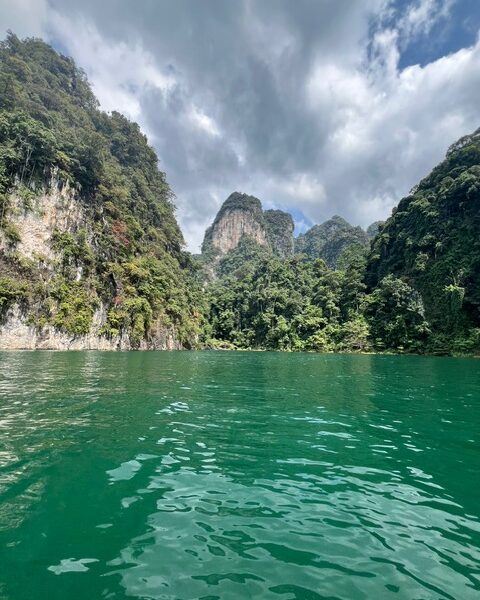
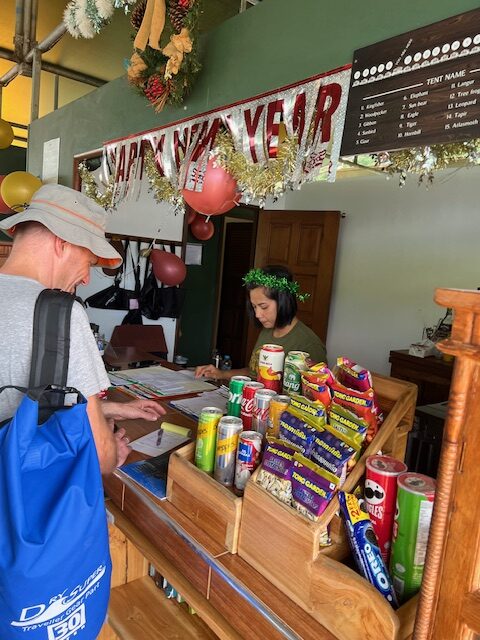

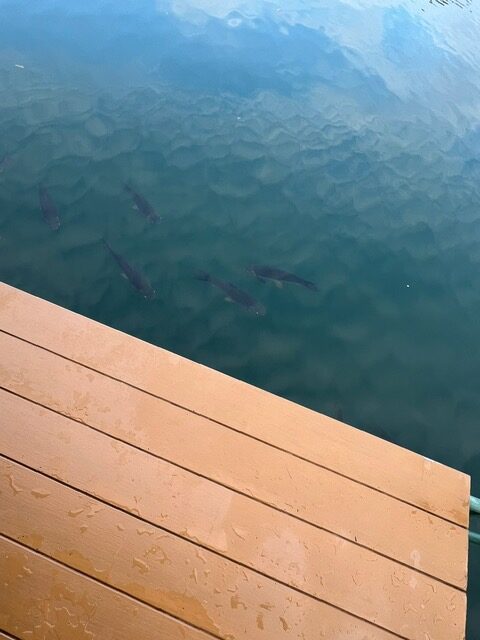

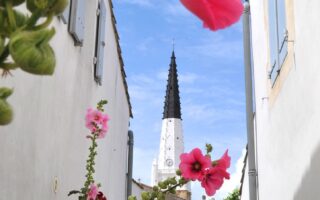
Thanks for sharing this!
Very interesting details you have noted, thanks for putting up.Blog monetyze